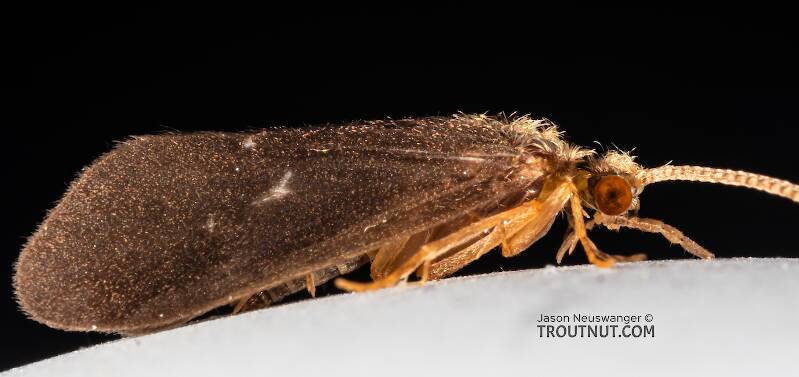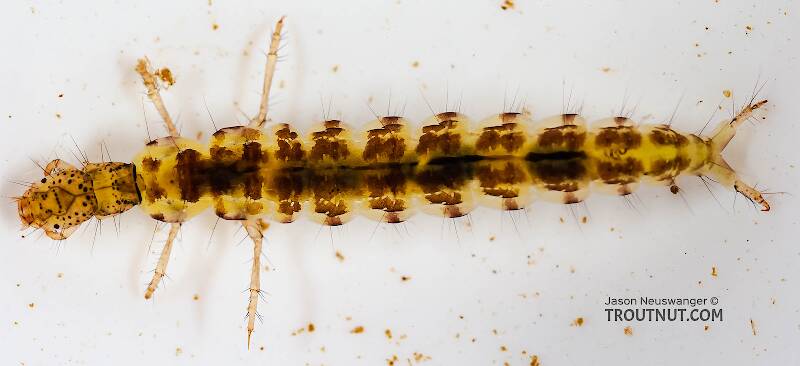
Hex Mayflies
Hexagenia limbata
The famous nocturnal Hex hatch of the Midwest (and a few other lucky locations) stirs to the surface mythically large brown trout that only touch streamers for the rest of the year.
Featured on the forum

I caught this tiny larva without a case, but it seems to key pretty clearly to to Glossosomatidae. From there, the lack of sclerites on the mesonotum points to either Glossosoma or Anagapetus. Although it's difficult to see in a 2D image from the microscope, it's pretty clear in the live 3D view that the pronotum is only excised about 1/3 of its length to accommodate the forecoxa, not 2/3, which points to Glossosoma at Couplet 5 of the Key to Genera of Glossosomatidae Larvae.

Troutnut is a project started in 2003 by salmonid ecologist Jason "Troutnut" Neuswanger to help anglers and
fly tyers unabashedly embrace the entomological side of the sport. Learn more about Troutnut or
support the project for an enhanced experience here.
Caddisfly Family Polycentropodidae
These small caddisflies are of occasional importance, but the family doesn't include any major superhatches.
Family Range
Hatching behavior
The pupae emerge on the surface.Egg-Laying behavior
Females of this family lay their eggs on the bottom, either by diving down or crawling down objects.Larva & pupa biology
Diet: Smaller aquatic insects
Current speed: Slow or still
Shelter type: Wide variety of nets and net-like structures
Specimens of the Caddisfly Family Polycentropodidae
1 Adult

This specimen is certainly Nyctiophylax and most likely Nyctiophylax affinis. I don't know my caddisfly parts well enough to definitively follow the Nyctiophylax key in Morse (1972), but that source states that affinis is the predominant Midwestern species, being widespread and common in the region where I found this one. The anatomy of this one seems to match those at least as well as the other two potential options based on range, Nyctiophylax uncus and Nyctiophylax banksi.
2 Larvae
Discussions of Polycentropodidae
Polycentropodidae or?
14 replies
Posted by LowBudget on Oct 1, 2013
Last reply on Jul 24, 2014 by Crepuscular
The first image is of a live caddis. It was collected from Trout Creek which is in the Delaware River watershed in upstate NY. The background is 1/4 inch ruled graph paper which is under the Petrie dish holding the caddis with water.

The second shows small silk nets found on rocks in the same stream during the same sampling.

I've been working all of my ID books including "Freshwater Macroinvertebrates of Northeastern North America" by Peckarsky.
The upper lip does not seem to have the T shape of a Fingernet caddis. It does have the heavy mandible with a brush of Polycentropodidae.
But, I'm not completely satisfied.
Anyone have thoughts on this?
Ed

The second shows small silk nets found on rocks in the same stream during the same sampling.

I've been working all of my ID books including "Freshwater Macroinvertebrates of Northeastern North America" by Peckarsky.
The upper lip does not seem to have the T shape of a Fingernet caddis. It does have the heavy mandible with a brush of Polycentropodidae.
But, I'm not completely satisfied.
Anyone have thoughts on this?
Ed
Start a Discussion of Polycentropodidae
References
- LaFontaine, Gary. 1981. Caddisflies. The Lyons Press.
- Swisher, Doug and Carl Richards. 2000. Selective Trout. The Lyons Press.
Caddisfly Family Polycentropodidae
Taxonomy
Genus in Polycentropodidae
Holocentropus
1
11
NeureclipsisLittle Red Twilight Sedges
0
0
NyctiophylaxDinky Light Summer Sedges
1
12
PolycentropusBrown Checkered Summer Sedges
1
4
4 genera (Cernotina, Cyrnellus, Plectrocnemia, and Polyplectropus) aren't included.



